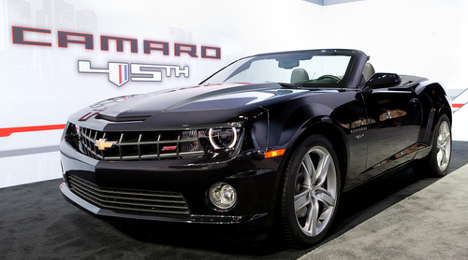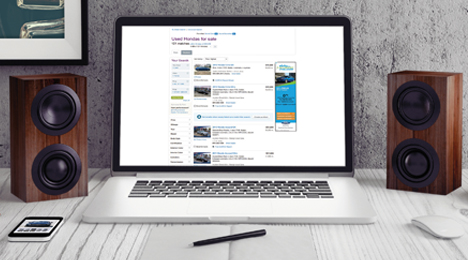Digital-marketing solution provider TapClassifieds recently announced its launch of TapCars, the company’s first vertical extension into the auto-marketing space, aiming to put dealer inventory in front of car shoppers.
“As our clients experience the power of inventory distribution marketing — where we make every car and truck ubiquitous across the digital landscape — they quickly realize they have missed a very large and highly engaged group of car buyers,” said Babak Hedayati, the chief executive officer of TapClassifieds.
The solution focuses on distributing inventory across various non-traditional marketplaces, such as Facebook, Pinterest, Twitter, Google+, YouTube, Craigslist, Backpage and other local classifieds.
TapCars is currently available from the company’s reselling partners in Alabama, Arkansas, California, Florida, Georgia, Illinois, Louisiana, Maine, Michigan, Minnesota, Missouri, New Jersey, New York, North Carolina, Ohio, Oregon, Pennsylvania, South Carolina, Tennessee, Texas, Washington and Wisconsin.
For more information on the company’s solutions, visit its site here.
On Thursday, TrueCar not only reported that it suffered a $14.7 million loss during the second quarter, but the company also said its founder, chief executive officer and chairman Scott Painter will step down as CEO later this year.
The company indicated Painter will retire when his successor takes office, which is expected to occur by year-end. TrueCar also mentioned Painter will continue to serve as chairman of TrueCar’s board of directors.
“After a decade of building TrueCar from an idea into a public company, I have come to the conclusion reached by many founders and entrepreneurs in my position: It is time for a change,” Painter said in a release that included details of the soft second-quarter performance that company officials alerted the investment community was coming.
“On behalf of the board of directors, I want to thank Scott for the creativity and vision he has demonstrated during the last decade in founding the company and leading it through its public offering,” said Todd Bradley, a member of TrueCar’s board of directors.
“We are grateful to Scott for the leadership demonstrated by making this difficult decision,” Bradley continued.
The news of Painter’s departure comes amid of flurry of activity regarding TrueCar and large dealer groups. Not only did TrueCar and AutoNation part ways at the end of the July, the company also settled a trademark dispute with Sonic Automotive.
And along with Painter’s move, TrueCar announced that Christopher Claus, former president of USAA Financial Advice & Solutions Group and a current director of TrueCar, has been named lead independent director. The company explained Claus will focus on the board’s search committee to find a new CEO as well as building deeper ties with USAA.
“I am honored to begin serving as the lead independent director and look forward to working closely with the leadership team to build upon and execute the vision that Scott has created, as well as maintain a strong partnership with the company’s largest affinity partner, USAA,” Claus said.
TrueCar’s leadership will have to steer the company through some difficult times. The company’s Q2 financial statement included nearly a $15 million net loss.
That said, the company reported an increase to $65.3 million in revenue, up from $50.5 million during Q2 of 2014.
“It was a tough quarter in relation to our initial guidance,” TrueCar chief financial officer Mike Guthrie said. “Notwithstanding that, we achieved notable successes.
“Traffic grew by 42 percent to 6 million unique visitors, and TrueCar Certified Dealers transacted a total of 190,358 vehicles on the platform, a quarterly record,” Guthrie continued. “New-car transactions represented 4 percent of total U.S. retail sales in the quarter.”
Editor’s note: Look for more coverage of developments at TrueCar coming in future editions of Auto Remarketing Today.
If you’re looking to market your high-tech vehicles, the customers most interested consume three key forms of media at considerably strong rates.
According to a recent J.D. Power report, those media — Internet, television and magazines — are consumed at very high rates by consumers shopping with in-vehicle technology in mind.
The J.D. Power 2015 U.S. Automotive Media and Marketing Report – Summer, fueled by a nationwide survey of 28,983 principal drivers of recently purchased or leased new vehicles (acquired between November 2013 and October 2014), takes a look at where shoppers interested most by technology in their cars consume their media and discovered the following statistics:
- 43 percent of new premium brand drivers and 28 percent of new non-premium brand drivers attributed their vehicle’s technology as one of the reasons they bought it.
- Of the new-vehicle drivers that bought their ride based on its technology, 69 percent access the Internet via smartphone and 54 percent via tablet – vs. 63 percent and 46 percent, respectively, who did not cite in-car technology as a reason for their car choice.
- New-vehicle drivers that chose their vehicle based on technology spend more time on the Internet for personal use, watch more television and read more magazines than those not seeking a vehicle based on its technology. Tech-savvy drivers are more likely to read a magazine via an app than those who chose their vehicle for other reasons (33 percent vs. 27 percent, respectively).
Arianne Walker, the senior director of automotive media and marketing at J.D. Power, points to tech-based advertising as the best way to attract tech-savvy shoppers.
“It’s important that auto manufacturers promote the technological virtues of their vehicles to consumers via the media they consume,” Walker said. “Targeting these technology seekers with the right messaging is critical to using marketing dollars efficiently to reach consumers who will actually buy new vehicles because of new technology.”
So what does the average tech-savvy shopping demographic tend to look like? As it turns out, there really isn’t a specific age bracket that outweighs the others in the area of primary tech interest — roughly a third of all new-car shoppers chose their vehicle based on its technology offerings. Here are J.D. Power’s findings in the report:
- 31 percent of men and 28 percent of women said one of the reasons they bought their new vehicle was due to it having the latest technology features.
- Looking at specific age groups, the following percentages of people chose their vehicle based on its tech features: 34 years and younger (31 percent), 35 to 54 years of age (28 percent), and 55 years or older (31 percent).
Here are a few more interesting findings about tech-savvy shoppers from the report:
- Brands with the most tech-focused shoppers include both premium brands (Lincoln, Infiniti, Cadillac and Audi) and non-premium brands (Mazda, Buick and Chrysler).
- They watch an average of 33 hours of television each week. Their favorite shows? “The Walking Dead,” “The Big Bang Theory” and “The Voice.”
- Tech-seeking drivers read an average of nine magazines, with a high rate of focus on topics such as wealth, science/technology and travel.
Even though not everyone cited technology as a primary reason for their purchase, new-car buyers, in general, are also increasing their levels of media consumption, albeit not quite to the extent of the tech-focused group.
- New-vehicle buyers read an average of eight magazines, with the biggest increased in the last year focusing on topics such as business/personal finance, wealth, men’s lifestyle/fitness/outdoor, travel, and women’s lifestyle.
- Younger new-vehicle drivers watch less television per week than older drivers: 34 years and younger (20 hours), 35 to 54 years old (24 hours) and 55 years and older (35 hours).
- Nearly 70 percent of new-car drivers utilize social media via websites or applications; Facebook was the most popular, followed by LinkedIn and Pinterest.
A little storytelling to grab potential shoppers’ attention on the Web goes a long way these days.
That’s according to the summer J.D. Power 2015 Manufacturer Website Evaluation Study released Monday that highlights how storytelling can help drive auto shopper customer satisfaction.
The semiannual study showed that OEMs are moving away from static text and pictures on their websites, and instead are telling engaging stories about their vehicles using more impactful visuals with in-depth descriptions and interactive content.
And it seems luxury automakers are doing the best job of providing such content to website users.
According to the study results, on the 1,000 point scale, BMW and Porsche ranked the highest with an overall score of 830 each.
The pair was followed by Mercedes Benz (819), Jaguar (816) and Land Rover (813).
Overall customer satisfaction with manufacturer websites it currently at 797, as the study measured the usefulness of automotive manufacturer websites during the new-vehicle shopping process by examining four key measures: information/content, appearance, speed and navigation.
J.D. Power pointed out “rich imagery paired with concise, informative text and interactive content” is becoming the new standard for showing off vehicles and product features on OEM websites.
And according to the study, information and content as well as website appearance are the two most important factors contributing to overall customer satisfaction on the sites.
"Buying a new vehicle is a big investment and shoppers want to be sure they are making an informed decision in selecting the right vehicle," said Arianne Walker, senior director, automotive media and marketing solutions at J.D. Power. "Manufacturers can influence shoppers by creating an emotionally connected online shopping experience through compelling, visually appealing storytelling to engage, entice, and reassure shoppers that they are making the right decision."
Walked also pointed out the two most improved brands in this study — BMW (830) and Volvo (789) — have recently worked to enhance the visual imagery of their sites and are now reaping the rewards.
Among other key findings from the study, 57 precent of new-vehicle shoppers who say they were “delighted” with their website experience say they are more likely to test drive a vehicle after visiting the site, compared with only 13 percent of those who say they were “disappointed”, showing the importance of websites to getting shoppers through the front doors of a dealership.
And don’t stop at just pictures of the inside of a vehicle — shoppers want to get insight into the interior of their potential new vehicle, as well.
The study found that 82 percent of in-market shoppers viewed vehicle exterior images on the site, while 80 percent checked out interior images, as well.
Interactive content, such as videos, are also expected and desired by auto shoppers.
According to the study, overall satisfaction is higher among the 49 percent of shoppers who watch as least one video on a manufacturer site than it is among those who did not watch a video. After viewing a video, customer satisfaction goes up from 781 to 813, according to study results.
The summer study is based on responses from more than 9,600 new-vehicle shoppers who indicate they will be in the market for a new vehicle within the next 24 months.
See the full rankings below:
|
Overall Customer Satisfaction Index Rankings
(Based on a 1,000-point scale)
|
| |
|
|
BMW
|
830
|
|
Porsche
|
830
|
|
Mercedes-Benz
|
819
|
|
Jaguar
|
816
|
|
Land Rover
|
813
|
|
Fiat
|
812
|
|
MINI
|
808
|
|
Cadillac
|
805
|
|
Ford
|
805
|
|
Chrysler
|
803
|
|
Dodge
|
803
|
|
Jeep
|
803
|
|
Audi
|
801
|
|
Lexus
|
801
|
|
Infiniti
|
799
|
|
Mazda
|
799
|
|
Ram
|
798
|
|
Hyundai
|
797
|
|
Industry Average
|
797
|
|
Volkswagen
|
794
|
|
GMC
|
793
|
|
Lincoln
|
793
|
|
Nissan
|
791
|
|
Volvo
|
789
|
|
smart
|
787
|
|
Toyota
|
785
|
|
Acura
|
784
|
|
Mitsubishi
|
781
|
|
Kia
|
779
|
|
Scion
|
779
|
|
Buick
|
776
|
|
Chevrolet
|
775
|
|
Subaru
|
774
|
|
Honda
|
769
|
If it seems like a new study on the prevalence of mobile shopping comes out every day, you’re just about right. And there’s a reason for that.
According to Search Optics, utilizing data provided from the US Mcommerce 2015: eMarketer’s Forecast and Trends report, the U.S. retail mobile market is expected to generate $76.79 billion in sales this year. Following this data, the report reveals that 71 percent of those polled, consisting of online and mobile shoppers, said they are influenced by digital marketing campaigns.
This presents an ever-growing opportunity for car dealers, where Search Optics data shows that 47 percent of customers used their mobile devices to “showroom shop.”
Here are a few other dealer-focused statistics provided by Search Optics:
- 29 percent of mobile shoppers use their mobile devices to look up inventory information
- 51 percent use their mobile devices to research prices, payments and offers
To check out an infographic prepared by Search Optics to help understand the importance of mobile selling efforts, click here.
It appears as though Independence Day weekend is the ideal time to target the summer whims of convertible lovers.
That’s according to an analysis from NADA Used Car Guide released Thursday, which highlighted a few manufacturer financing incentives that should prove particularly appealing to July 4 shoppers who enjoy the top-down side of life.
“If horsepower and performance are on their requirement list, shoppers might consider 72 months of zero percent financing on Chevrolet’s Camaro,” said Larry Dixon of NADA Used Car Guide. “Paying nothing in interest over the life of a loan helps you reach a positive equity position sooner.”
NADA Used Car Guide’s executive analyst Jonathan Banks added: “If your taste in vehicles changes often and you don’t want to put any money down on a purchase, Mazda is leasing their MX-5 (Miata) roadster for 24 months with nothing down.”
Here are a few other top-down suggestions from NADA Used Car Guide:
- MINI Cooper S Convertible or Cooper S Roadster – 1.9 percent APR for 36 months from MINI Financial Services, with no payments for up to 90 days.
- Volkswagen Beetle Convertible – 0.9 percent APR for 60 months.
For a list of solid convertible options for both new- and used-vehicle shoppers, check out the organization’s Perspective: New and Used Convertibles for Under $35,000 here.
Long gone are the days where a dealership could adequately maintain its inventories by utilizing traditional methods of vehicle acquisition alone. That’s according to the folks at Autotrader, who hosted the company’s Interactive Dealer Summit in the North Carolina capital last Thursday.
One of the workshops for dealers at the event, titled “The Frond-End Fundamentals: Transforming the Art of Selling to the Science of Results” was presented by Glenn Pereira, Autotrader’s manager of industry education.
Pereira hit on what the company sees as the eight key areas that successful dealerships should focus on the front end of the vehicle sales process, from vehicle selection all the way to customer handling. One topic during the event proved particularly poignant: dealers can’t stay in a selling-only mindset.
“You can’t afford to only sell cars,” Pereira said. “You need to be in the business of buying cars, as well.”
This statement, made while discussing the vehicle acquisition process, resonated well with the dealers in attendance at the event. Pereira went on to break down the traditional and non-traditional methods of vehicle acquisition.
He explained that a good acquisition strategy involves pursuing every avenue possible. In addition to more traditional methods, like vehicle trade-ins and auction purchases, Pereira heavily emphasized the use of more non-traditional acquisition methods, such as a car-buying campaign or a “trade-in marketplace” on the dealer’s own website.
“It’s a good plan to have a buying center without the contingency of selling them a car,” Pereira said.
Autotrader says its most successful customers advertise their car-buying intentions separately and in addition to their own vehicle sales. While some dealerships have an acquisition manager on staff, some of the larger groups will even have an entire acquisition team dedicated to targeting ideal inventory.
For more information and further Autotrader advice on the acquisition process, visit its site here.
In announcing its purchase of Dealix and Autotegrity last week, Autobytel said it plans to grow the used-car side of its business.
So, Auto Remarketing reached out to Autobytel’s president and chief executive officer, Jeff Coats, to find out more about why the company saw a need to expand its presence in the pre-owned space.
“The used-car market is very large and growing more quickly than new — and right now, used cars represent only 9 percent of our current revenue, so there is plenty of upside opportunity for us” Coats said. “According to IHS data (formerly Polk) many consumers are in the market for both new and used, so not focusing on used is definitely a missed opportunity.”
According to Coats, Dealix’ revenue from pre-owned leads accounts for over 16 percent of its overall revenue, nearly double the percentage of Autobytel’s former numbers. The acquisition of Dealix also includes its site, UsedCars.com.
“With UsedCars.com, we now have the ability to enhance our used-car lead program, and we are also excited about the relaunch of Car.com,” Coats said.
Coats touched on this topic further during a conference call on Thursday when the company formerly announced the acquisition, briefly outlining a bit of Autobytel’s strategy in the space.
“They do generate a pretty good volume of their leads off of their UsedCars.com site, but I think that site probably has not been as strongly invested in over the last couple of years as we would probably now, because we view that as an integral part of our strategy going forward,” Coats said. “We will definitely be beefing that up and continuing to focus on that as we are really beginning to grow our used-car pay-per-lead business.”
Auto Remarketing also followed up with Coats on the used-car beta test platform the company had previously mentioned alongside its acquisition news to see if any details could be fleshed out.
“Our latest used-car test involved utilizing our existing SEM strategies, which had been very successful for us on the new car side, to drive in-market pre-owned car buyers to dealers,” Coats said. “We really hadn’t focused on that until now.”
Customers are spoiled for choice. While used vehicles certainly portray more uniquities than their new-vehicle counterparts due to the variations in their histories, you still have to show a customer why the particular car on your lot better meets his or her needs when compared to the similarly priced, similarly equipped car across the street, whether it is from the same brand or not.
And this is where your advertisements come in. If your customer is not standing right in front of you, it can be difficult to point out what makes your listing special compared to all of the other vehicles of the same type that customers find while shopping around.
Auto Remarketing has assembled some ways you can connect with customers with the information many say they’d like to see, not only before the purchase but after the sale as well, according to research.
This is the third and final part of a series on advertising ideas for dealers. To check out Part 1 and/or Part 2, click on their respective links.
In the previous iteration of this series, we explored a study from Accenture, titled What Digital Drivers Want, which reflected the influence of third-party sources for car shoppers (including both new and used).
Aside from comparison shopping sites, those surveyed in the Accenture study also fleshed out some things they would like to see in addition to the typical descriptive listing features when viewing a vehicle listing. Fifty-nine percent said a virtual demonstration of the vehicle would help make their decision-making process easier, while 27 percent said that online chat with dealers is also helpful.
Shoppers also said that an array of advertised, customized services may influence their decision, such as the following:
■ Free oil changes / maintenance options (78 percent)
■ Access to manufacturer’s partner membership services without paying the annual fee (52 percent)
■ A test drive tailored to the car (38 percent)
■ Car membership club with special benefits (33 percent)
■ Free music or entertainment downloads (27 percent)
There are also items that shoppers from the What Digital Drivers Want study want to receive directly from the dealer or manufacturer after their purchase. Seventy-two percent said they would like to receive special maintenance service offers. Here are a few others advertising options that the customers wanted after the sale, according to Accenture:
■ Special offers from current vehicle manufacturer (49 percent)
■ New technology add-ons (48 percent)
■ Performance comparisons over the lifetime of the vehicle (36 percent)
■ Part exchange deals available for upgrading the vehicle (34 percent)
■ Information on new models in development (30 percent)
■ Additional accessories purchased by others with a similar vehicle (28 percent)
■ Other owners’ experiences and comments on the same vehicle (25 percent)
Automotive shoppers, now more than ever, have a wealth of knowledge available at their fingertips.
Where can a dealer place their offerings to find the right customer at the right time? The options in the digital space are virtually unlimited — pun intended.
As part of our journey to help you find the folks most likely to be interested in buying from you, Auto Remarketing set our sights on one of the sources of information frequently utilized by auto shoppers: third-party websites.
This is Part 2 in a series on advertising ideas for dealers. To explore what devices customers are using to shop, check out Part 1.
According to a recent worldwide automotive survey from Accenture, titled What Digital Drivers Want, 37 percent of those surveyed in the United States who were either close to shopping for a new or used vehicle soon (or anticipated the need in the future) said that automotive sites and reading online publications or car magazines were the most influential factors on their decision making process when buying a car.
This influence was fourth in line, following the fact they wanted or needed a car (51 percent), advice/recommendations from friends, family or colleagues (40 percent), and an encounter with a salesman or from visiting the dealership in person (38 percent).
Thirty-four percent of those surveyed also value manufacturers’ websites as well as offline information, while 32 percent were influenced by dealer websites.
When asked which online channel would help make the process easier, the majority (69 percent) pointed to comparison shopping sites.
And that’s where one possible option, third-party automotive sites, come in.
According to a recent study, titled The Digital Influence: How Online Research Puts Auto Shoppers In Control — conducted independently by C+R Research, on behalf of Cars.com — customers who were either in-market shoppers for a new or used vehicle (or had recently purchased a new or used vehicle) said that independent research sites were the leading “go-to” source for information.
The 1,005 shoppers surveyed — with ages ranging from 21 to 60 and split roughly evenly between in-market shoppers and recent buyers — were asked about 24 separate sources they encountered during their vehicle search and ranked the influence of each.
On average, those surveyed said they were influenced by six to seven different sources of information. but only relied on one or two of those sources as a “go-to” source(s).
Two-thirds of the shoppers said that one of their go-to sources was an online source. And 50 percent said their top online source was independent research sites.
Auto Remarketing reached out to another third-party source, Autobytel, to see why that may be the case. When asked why a third-party source may be favored, if not trusted, more than a dealership or manufacturer site, Scott Pechstein, the vice president of national sales for Autobytel, attributed the customer ability to research many different brands through a variety of mediums.
“There is a comfort level associated with unbiased information that doesn’t skew in favor of one brand versus another, which is why consumers continue to rely on third-party information today like they did 20 years ago when Autobytel pioneered the automotive Internet,” Pechstein said.
And this is where dealers can benefit from a partnership with a third-party site. Pechstein said that just in the last four years, more than 3.85 million new and used vehicles were purchased via consumer-submitted leads through the Autobytel network.
And Pechstein’s company is just one of many successful third parties in the market.
Cars.com also conducted a separate impact study along with one of its customers, the Denver-area Groove Automotive Group, titled Unpacking Big Data: Analyzing Online Shopper Behavior Beyond the Last Click.
The study aimed to see if shoppers acted differently when being led to one of Groove’s websites from Cars.com, compared to the behavior of those arriving at the dealer site via other means. This was meant to judge the “quality” of traffic being funneled through the third-party source.
Gabriel Montano, the operations manager at Groove Automotive, said he found that shoppers that ended up on the Groove sites from Cars.com had lower bounce rates, higher page views per session, spent more time on the site and viewed more inventory on the site, suggesting that these were all signs that the traffic from the third-party source were more interested in engaging with the dealership than from other sources.
One purpose that third-party sites like Cars.com, Autobytel and others serve is to help customers sift through vehicle choices online. This can be helpful for dealers trying to expose their inventory to those who are searching around, trying to make up their mind which vehicle they want to go with.
“What we have found in our analysis is that car buyers are generally undecided up to the point of purchase, which means consumers who visit Autobytel are actively narrowing down their choice,” Pechstein said. “For many, this doesn’t occur until the week they actually buy.
“What we have also found is that roughly half of consumers who submit a new-car request end up buying used and vice-versa, and about half who submit a request for a particular brand end up buying a different brand altogether,” he added.
On that note, Groove’s Montano agrees.
“Consumers jump all over the place,” he said. “Having a brand, exposing your brand and having a resource to do so is important for a dealership’s digital marketing strategy.”
Stop in tomorrow to see the final installment of this series where Auto Remarketing will further explore what kind of advertisements and communications customers like to receive from dealers before and after the sale.












